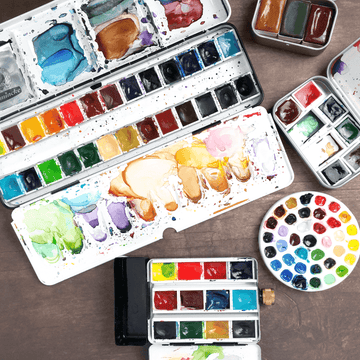There is no hard fast rule regarding the number of colours one needs in their palette. It is yet another overwhelming decision that awaits the beginner, and can also be quite difficult for the indecisive artists among us.
There's no need to worry though, as there’s no way to go “wrong” about this. Here are a few suggestions, from the very basic to the more elaborate.
One colour
As simple as that, we can paint using just one colour. Most people I know who’ve started that way would go for a Payne’s grey, a neutral tint or a black paint. It’s an excellent way to learn how to handle the paint, the water, the brush and the paper.
One colour is extremely easy to carry around and it’s also very inexpensive. Working with just a dark paint can also allow you to focus on the play of light and shadows, to understand contrast better.
It’s perfect for learning the medium, or working through focused studies of lighting, tonal values, and composition.
Three colours
With three colours, we can create any type of colour triad we want. The most common is a primary colour triad (cyan, magenta and yellow or red, yellow and blue are good examples).
The advantage of reaching for primary colours is that it can help work out how to mix our colours, but they are not the only option. Painter Anders Zorn would often paint in oil with only four colours: white, black, red and yellow ochre.
We could convert that into a watercolour triad by keeping the black, red and yellow ochre, our white would be the paper. There is so much variety in the yellow, red/magenta and blue/cyan ranges that we can customise any kind of triad. You can choose your favourite from those three categories and see what kind of triad that makes.
A palette of three colours is still very easy to carry and not very expensive. However, it is much more versatile than a single colour.

Six colors
The most common way of selecting a palette of six colours is to choose two hues for each primary colour. This means having a cool yellow, a warm yellow, a magenta (or cool red), a warm red, a cool blue (or cyan) and a warm blue. Expanding the range of the primary triad this way makes for the most vivid mixes easily, and it’s also a very quick way to mix muted colours.
Of course, you could pick any six colours you want. I recently set up a palette of six colours in my Etchr palette. I did a few text mixes and ended up selecting a yellow, a magenta, a red, a greenish blue, a reddish blue, and a brown. I realised that I rarely need two yellows and can work with a single neutral yellow. Doing that leaves me with a space I can use for a brown, to quickly mix with the blue to have a nice neutral grey.

Twelve colours
If we are looking at ready-made, prepackaged palettes, twelve colours is the most common format available. They will usually have a variation of two yellows, two reds, two blues, two greens, two earth tones, black and white.
Depending on the specifics of each palette, it is usually a good basic selection. It’s not optimal or the most versatile, in my opinion, but a decent place to start. It’s very easy to replace colours gradually as we get more familiar with the set.
With twelve colours, there’s a nice balance of primary, mixing colours and convenience colours (like green). It’s more complex to learn how to mix specific colours with twelve paints than with three, but it’s still a very manageable number of options.
Twenty-four colours or more
That’s a lot of colours! With a selection this large, we have plenty of room for all the convenience colours we need, plus a solid selection of basic colours. There’s even space to include personal favourites. The more I paint, the more I realise that I often reach for colours that are never part of smaller sets. With a large palette, I can have those colours along with the rest and not feel like I’m missing something. That’s what I like to call a “signature” palette.
Some palettes of this size will be quite large, but you can also find small palettes crafted to hold a lot of colours (the Etchr palette being one of them!). It’s also a possibility to only fill a few of the wells, and add more gradually. The size of the palette and it’s wells will depend on your needs.
So…how many do you actually need?
Ultimately, it’s all up to what you want to achieve. More colours is not necessarily better, just as less colours can become too time-consuming (from having to mix everything). The takeaway is that there’s no need to worry about the number of colours in your palette, but it's a good start to know your options. Go at your speed, follow your instinct. After all, any number of colours is fine as long as one paints.



2 comments
Excellent article. I have been working to simplify my palette. This is most helpful. Thank you.
Thank you for the good advice. Do you have some more suggestions concerning other water colour characteristics such as stain power, transparency, and gradulation? How do we fit those factors into pallet selection?